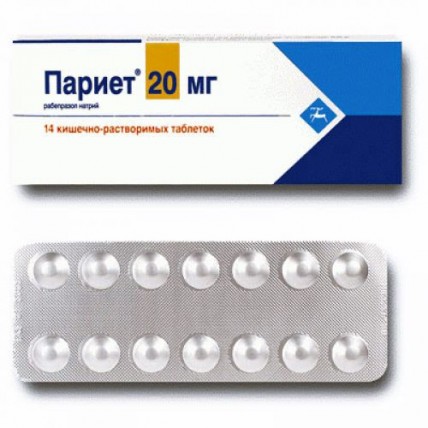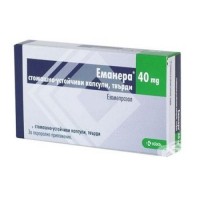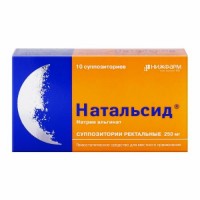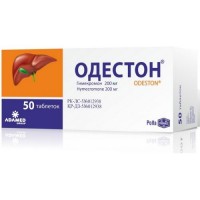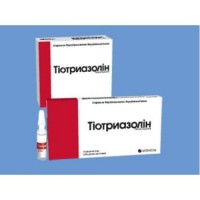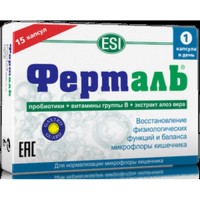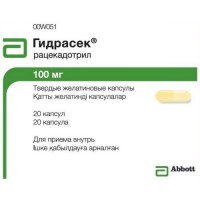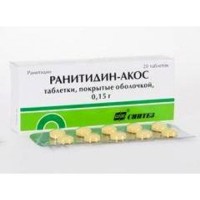Pariet 14s 20 mg coated tablets
- $88.30
Out Of Stock
The instruction for medical use
of Pariet® medicine
the Trade name
of Pariet®
the International unlicensed
name Rabeprazol Lekarstvennaya
the Tablet form, 20 mg covered with a kishechnorastvorimy cover
Structure
One tablet contains
active agent - a rabeprazol of sodium of 20 mg (it is equivalent to a rabeprazol of 18.85 mg),
excipients: mannitol, magnesium oxide, hydroxypropyl cellulose slabozameshchenny (hypro rod), hydroxypropyl cellulose, magnesium stearate, ethanol *,
internal cover: ethyl cellulose, magnesium oxide, ethanol *,
the cover soluble in intestines: gipromelloza phthalate, a diacetylized monoglyceride, talc, the titan dioxide (E 171), ferrous oxide yellow (E172), wax of karnaubskiya, ethanol *, the water purified *, butane-1-ol *
Edible Ink Red A1 ink: shellac white, ferrous oxide red (E172), wax of karnaubskiya, alcohol dehydrated *, glycerin ether with fatty acids *, 1 butanol.
*-
the Description of the Tablet, coated light yellow color, round shape, with a biconvex surface, on one party marking by Î243 ink evaporates in the course of production.
Pharmacotherapeutic group
Antiulcerous drugs and drugs for treatment of a gastroesophageal reflux. Inhibitors of the protonew pump. Rabeprazol.
The ATX A02BC04 code
the Pharmacological
Rabeprazol Pharmacokinetics Absorption properties of sodium is issued in the form of tablets with a kishechnorastvorimy cover. Such form of release is explained by instability of a rabeprazol of sodium in acidic environment. Therefore absorption of medicinal substance begins only in intestines. Rabeprazol of sodium has the high speed of absorption, and its maximum levels in plasma are defined approximately by 3.5 h after reception of a dose of 20 mg.
The maximum concentration of a rabeprazol of sodium in plasma (Cmax) and an indicator of AUC change linearly in the dose range from 10 to 40 mg. The absolute bioavailability of an oral dose of 20 mg (in comparison with an intravenous dose) is about 52%. Besides, the bioavailability of drug does not increase after repeated reception. At healthy faces the half-life period in plasma is about an hour (from 0.7 to 1.5 h), and the general clearance – 3.8 ml/min. At patients with a chronic disease of a liver the indicator of AUC raised twice, in comparison with healthy volunteers that reflects decrease in level of presistemny metabolism, and the half-life period increased in plasma by 2 – 3 times. Neither reception time, nor a concomitant use of antacids had no significant impact on absorption of a rabeprazol of sodium. Reception of a rabeprazol with food of high fat content can lead to a delay of its absorption more than for 4 hours, however the indicator of Cmax and level of absorption (AUC) do not change.
Distribution
the Level of linking of a rabeprazol of sodium with proteins of plasma of the person makes about 97%.
Metabolism and removal from an organism
Healthy volunteers
After reception of a single dose of a 14C-marked rabeprazol of sodium in tablets with a kishechnorastvorimy cover the removal of not changed medicine did not decide on urine. About 90% of a dose were removed with urine, mainly, in the form of two metabolites: conjugates of mercapturic acid (M5) and carboxylic acid (M6) and also in the form of two unknown metabolites which are also revealed in preclinical toxicological trials. The rest of a dose was brought out of an organism with a stake. Total removal of drug made 99.8%. It indicates the low level of removal of metabolites of a rabeprazol of sodium with bile. The main metabolite of drug is monothioester (M1). The only active metabolite, a dimethyl metabolite (M3), was found only in low concentration and only in one subject which accepted rabeprazol sodium in a dose of 80 mg.
Patients with a renal failure of a final stage
the patients with a stable renal failure of a final stage needing the supporting hemodialysis (clearance of creatinine & lt, 5 ml/min. / 1.73м2), from tablets with a kishechnorastvorimy cover had very similar distribution of a rabeprazol of sodium to that at healthy volunteers.
Patients with the compensated cirrhosis
Patients with the compensated cirrhosis well transferred daily reception of a rabeprazol of sodium in a dose of 20 mg though the indicator of AUC raised almost twice, and the indicator of Cmax increased by 50%, in comparison with healthy faces of the corresponding floor.
Older persons
At older persons the removal of a rabeprazol of sodium from an organism is a little reduced. Daily reception of a rabeprazol of sodium in a dose of 20 mg within 7 days led to increase in an indicator of AUC almost twice, and Cmax indicator - for 60%, in comparison with young healthy volunteers. However signs of accumulation of a rabeprazol in an organism were not defined.
Polymorphism of CYP2C19
According to observations, after daily oral administration of a rabeprazol in a dose of 20 mg within 7 days the indicators of AUC and t1/2 at slow metabolizator on CYP2C19 approximately in 1.9 and 1.6 times exceeded the corresponding indicators at fast metabolizator whereas the indicator of Cmax increased only by 40%.
The pharmacodynamics
the action Mechanism
Rabeprazol - active agent of drug, belongs to a class of anti-secretory drugs, the substituted benzimidazoles.
Rabeprazol suppresses secretion of gastric acid at the expense of specific inhibition of N+/K+-ATFazy enzyme on the secretory surface of covering cells of a stomach. This fermental system represents the acid (proton) pump therefore rabeprazol sodium, the blocking last stage of production of acid, belongs to inhibitors of a proton pomp of a stomach. Effect of drug depends on a dose, consists in inhibition of basal and stimulated secretion of acid, irrespective of the nature of the stimulating factor. Rabeprazol is deprived of anticholinergic properties.
The anti-secretory activity
After oral administration of 20 mg of the drug Pariet® in tablets anti-secretory action develops within one hour. Inhibition level basal and stimulated food of secretion of acid in 23 hours after reception of the first dose of the drug Pariet® is 69% and 82%, respectively, and duration of inhibiting effect - till 48 o'clock. Such duration of pharmakodinamichesky action exceeds the forecasts based on assessment of one of pharmacokinetic parameters, namely, the half-life period (which is about one hour). This action can be explained with more long linking of a rabeprazol with N+/K+-ATFazoy enzyme of covering cells of a stomach. Force of inhibiting effect of the drug Pariet® on secretion of gastric acid increases at repeated administration of drug with a frequency a little once a day when three days later the equilibrium level of inhibition is established. The secretory activity begins to return to normal in 1-2 days after the termination of intake of medicine.
Action on serum gastrin level
In clinical trials the patients received tablets rabeprazol 20 mg with a frequency to 5 years once a day. Levels of gastrin of serum increased in the first 2-8 weeks of therapy that indicates inhibition of secretion of gastric acid. During continuation of therapy of additional increase in the average level of gastrin of serum it was not observed. This indicator returned to norm range in 2 – 4 weeks after the therapy termination.
Action on enterokhromaffinopodobny cells (ECL)
was not determined By the stomach bioptata taken from antral and fundal departments of a stomach from 500 patients taking a pill rabeprazol or comparison drug up to 8 weeks permanent changes of ECL cells, weight of gastritis, frequency of development of atrophic gastritis, an intestinal metaplasia or spread of a H.pylori-infection. More than 400 patients receiving treatment rabeprazoly (20 mg/days) up to one year, had a low frequency of development of a hyperplasia of ECL cells, comparable with that for omeprazolum (on 20 mg/days). Cases of development of adenomatoid, dysplastic or neoplastic changes of ECL cells of a mucous membrane of a stomach it was not defined.
Other actions
Systemic actions of a rabeprazol on central nervous system, a cardiovascular system and respiratory organs are at the moment not established. Oral administration of the drug Pariet® in a dose of 20 mg within 2 weeks did not lead to any action on function of a thyroid gland, metabolism of carbohydrates or levels of parathyroid hormone, cortisol, estrogen, testosterone, prolactin, a glucagon, follicle-stimulating hormone (FSG), luteinizing hormone (LH), renin, Aldosteronum or somatotropic hormone in a blood-groove.
Indications
- a peptic ulcer of a stomach and duodenum in an aggravation stage
- erosive or ulcer forms of a gastroesophageal reflux disease (GERD)
- the long-term supporting treatment of a gastroesophageal reflux disease (maintenance therapy of GERD)
- symptomatic treatment of a gastroesophageal reflux disease from moderated to heavy degree (symptomatic therapy of GERD)
- Zollingera-Ellison's syndrome
- as a part of the combined antibacterial therapy for Helicobacter pylori eradikation at patients with a peptic ulcer
the Route of administration and doses
of the Tablet Pariet® cannot be chewed or crushed, and it is necessary to swallow entirely. Time of administration of drug has no significant impact on activity of a rabeprazol of sodium.
Adult/elderly patients
the Peptic ulcer of a stomach and duodenum in a stage of aggravation
Is recommended to accept inside on 20 mg once a day in the morning.
In a peptic ulcer of a stomach in aggravation stages, healing comes within 6 weeks, but 6 more weeks of therapy can sometimes be required.
In a peptic ulcer of a duodenum in an aggravation stage
the healing of an ulcer occurs within 4 weeks, but 4 more weeks of therapy can sometimes be required.
Erosive or ulcer
For treatment of this state about 20 mg are recommended to take the forms of a gastroesophageal reflux disease inside once a day. Treatment in such dose should be continued within 4 - 8 weeks.
The long-term supporting treatment of a gastroesophageal reflux disease (maintenance therapy of GERD)
Is recommended to accept inside on 10 mg or 20 mg once a day, depending on the response of the patient to treatment.
Symptomatic treatment of a gastroesophageal reflux disease from average to heavy degree (symptomatic therapy of GERD)
Is recommended to accept inside on 10 mg or 20 mg at patients with GERD without esophagitis once a day. In case of lack of the response to treatment in 4 weeks of therapy, it is necessary to perform additional examination of the patient.
After stopping of symptoms, for prevention of their subsequent emergence it is necessary to take the drug inside in a dose of 10 mg once a day on demand.
Zollingera-Ellison
Naznachayemaya's syndrome a dose depends on a clinical picture. The recommended initial dose of 60 mg once a day, but can raise up to 120 mg a day depending on need. Reception of a dosage to 100 mg is possible once a day, and in case of reception of 120 mg the reception of tablets can be divided 60 mg 2 times a day. Therapy is carried out until there are corresponding clinical indications.
Eradikation Helicobacter pylori
Dlya is recommended to an eradikation of H. pylori intake on 20 mg 2 times a day in a combination with the corresponding antibiotics: Париет® in a dose of 20 mg 2 times a day + klaritromitsin 500 mg 2 times a day + amoxicillin of 1 g 2 times a day.
Treatment duration: 7 days.
If schemes of an eradikation demand administration of drugs once a day, the pill Pariet® needs to be taken in the morning, before a breakfast and though neither time of day, nor food affect activity of a rabeprazol of sodium, such mode of administration of drug promotes the best commitment to treatment.
Patients with a renal and liver failure
with a renal failure of correction of a dose it is not required to Patients.
At patients higher levels of influence of a rabeprazol of sodium at its reception in the set dose decide on average and easy degree of a liver failure, in comparison with healthy patients. Treatment of patients with a heavy liver failure drug Париет® 10 of mg or 20 mg has to be carried out with care.
Elderly patients
it is not required to Elderly patients of correction of a dose.
Patients of children's age
of Pariet® it is not recommended for use for children, due to the lack of experience of use in this age group.
Side effects
of the Tablet Pariet® in general were well transferred by adults and teenagers in clinical trials. The reported undesirable phenomena were characterized by generally easy/average weight, were temporary.
Undesirable reactions are systematized concerning each of the systems of bodies with use of the following classification of frequency of occurrence: very often (≥1/10), it is frequent (≥1/100, & lt, 1/10), infrequently (≥1/1000, & lt, 1/100), is rare (≥1/10000, & lt, 1/1000), is very rare (& lt, 1/10000) and unknown frequency.
Often (≥1/100, & lt, 1/10)
- infections
- insomnia, a headache, dizziness
- cough, pharyngitis, rhinitis
- diarrhea, vomiting, nausea, an abdominal pain, a constipation, a meteorism
- nonspecific pain, a dorsodynia
- an asthenia, a grippopodobny syndrome
Infrequently (≥1/1000, & lt, 1/100)
- nervousness, drowsiness
- bronchitis, sinusitis
- dyspepsia, dryness in a mouth, an eructation
- rash, an erythema
- myalgia, an arthralgia, spasms of legs
- fractures of a hip, wrist, backbone *
- infections of urinary tract
- a fever, fever, a stethalgia
- increase in levels of enzymes of a liver
Is rare (≥1/10000, & lt, 1/1000)
- a hypomagnesiemia, thrombocytopenia, a neutropenia, a leukopenia, a leukocytosis
- hypersensitivity (including a face edema, hypotension and dispnoe) - anorexia
- a depression
- a disorder of vision
- gastritis, stomatitis, disturbance of taste
- hepatitis, jaundice, hepatic encephalopathy (were observed at patients with cirrhosis)
- an itching, the increased sweating, bullous rashes
- interstitial nephrite
- increase in weight
is Very rare (& lt, 1/10,000),
- a mnogoformny erythema, the toxic epidermal necrolysis (TEN), Stephens-Johnson's syndrome
With an unknown frequency
- a hyponatremia, a hypomagnesiemia **
- confusion of consciousness
- peripheral hypostasis
- a gynecomastia
the Erythema, bullous rashes and reactions of hypersensitivity usually pass after the treatment termination.
Significant deviations of the laboratory indicators connected with the Pariet® drug treatment were not defined.
* Insignificant increase in risk of changes, especially at intake of inhibitors of a proton pomp in high doses and more than 1 year, mainly at elderly patients or with risk factors.
** This side effect was in most cases observed at the patients taking the drug during 1 year.
Contraindications
- hypersensitivity to a sodium rabeprazol, the substituted benzimidazoles or to any excipients
- pregnancy and the period of a lactation
- children's and teenage age up to 18 years
Medicinal interactions
the System of P450 cytochrome
Rabeprazol, like other inhibitors of a proton pomp (IPP), is metabolized by the system of P450 (CYP450) cytochrome of the liver providing metabolism of medicines. According to results of researches with participation of healthy volunteers, rabeprazol, accepted in the form of tablets, does not enter pharmacokinetic or clinically significant interactions with warfarin, Phenytoinum, theophylline or diazepam (irrespective of the subject's belonging to group of fast or slow metabolizator of diazepam) which are metabolized by the system of CYP450 cytochrome of a liver.
The combination with the antibacterial
drugs Combination with antibacterial drugs was studied in a cross research with four periods with participation of 16 healthy volunteers who received only rabeprazol in a dose 20 mg, only amoxicillin in a dose of 1000 mg, only klaritromitsin in a dose of 500 mg, or a combination of a rabeprazol, amoxicillin and a klaritromitsin. Indicators of AUC and Cmax of a klaritromitsin and amoxicillin were similar during the combined treatment and monotherapy. Indicators of AUC and Cmax of a rabeprazol at its appointment in a combination were for 11% and 34% above, and the 14-hydroksiklaritromitsina (active metabolite of a klaritromitsin) – for 42% and 46% is higher, in comparison with monotherapy. Such increase in exposure of a rabeprazol and 14-hydroksiklaritromitsin is not considered clinically significant.
Has the interactions connected with inhibition of secretion of Rabeprazol gastric acid expressed and long inhibiting effect on secretion of gastric acid. Can enter interaction with medicinal substances which absorption depends on size rn Wednesdays. In particular, rabeprazol promotes decrease in the minimum level of a ketokonazol by 30% and increase by 22% of the corresponding indicator of digoxin at healthy faces therefore observation for possible dose adjustment can be required by the patients accepting rabeprazol along with digoxin, ketokonazoly or other medicines with rn-dependent absorption.
Interactions with atazanaviry
At the healthy volunteers accepting at the same time atazanavir 300 mg / ritonavir 100 mg and omeprazolum (on 40 mg once a day) or atazanavir 400 mg with lansoprazoly (on 60 mg once a day), significant decrease in level of influence of an atazanavir was defined. Level of absorption of an atazanavir depends on size rn Wednesdays. Though the concomitant use of these drugs with rabeprazoly was not studied, similar results can be assumed also for other inhibitors of a proton pomp. In this regard reception of IPP, including rabeprazol, at treatment atazanaviry is contraindicated.
Interactions with antacids
In clinical trials the concomitant use of antacids with rabeprazoly where it was appropriate was studied, and in one special pharmacokinetic research devoted to this interaction clinically significant interactions with gel of aluminum hydroxide or magnesium hydroxide were not revealed.
Interaction with food
In the clinical trial of interaction of a rabeprazol with food of low fat content conducted in Japan, clinically significant interactions of drug with food was not defined. Reception of tablets of a rabeprazol with food of high fat content can lead to a delay of its absorption more than for 4 hours, however the indicator of Cmax and level of absorption (AUC) of drug in these conditions do not change.
Interaction with cyclosporine
In incubation researches with microsomes of a liver of the person of in vitro was shown inhibiting effect of a rabeprazol on metabolism of cyclosporine at concentration of the semi-maximum inhibition (IC50) of 62 µmol/l - to concentration which is 50 times higher than Cmax indicator at healthy volunteers in 14 days of reception of a rabeprazol in a dose of 20 mg. Such degree of inhibition is similar to the corresponding indicator of omeprazolum in equivalent concentration.
The methotrexate
of the Message about cases, the published results of population pharmacokinetic researches and the retrospective analysis show that simultaneous introduction of IPP and methotrexate (first of all, in high doses, see the instruction for use of a methotrexate) can increase levels of a methotrexate and/or its metabolite of a hydroxymethotrexate in blood serum and prolong the period of their semi-removal. Nevertheless, no official researches of medicinal interaction of a methotrexate with IPP were conducted.
Special instructions
the Symptomatic response to the Pariet® drug treatment does not exclude presence of a malignant tumor of a stomach or duodenum therefore before administration of drug of Pariet® it is necessary to be convinced of lack of new growths. The patients receiving long therapy by drug (especially more than one year) have to undergo regular inspection.
It is impossible to exclude risk of cross-reactions with other inhibitors of a proton pomp or with the substituted benzimidazoles.
Patsiyentov it is necessary to warn that the tablets Pariet® need to be swallowed entirely, they cannot be chewed or broken.
Париет® children as experience of use of drug in this age group is absent are not recommended to appoint.
There are messages from post-marketing use of a rabeprazol about development of dyscrasias of blood (case of thrombocytopenia and a neutropenia). In most cases, when it was not succeeded to find out the alternative reasons of these states, they did not cause complications and passed after cancellation of a rabeprazol.
In clinical trials and during post-marketing use of a rabeprazol the change of activity of enzymes of a liver is noted. In most cases, when it was not possible to find out the alternative reasons of these states they did not give complications and passed after cancellation of a rabeprazol. In a research of patients with easy and average degree of a liver failure and the control group which is picked up for age and sex vital issues of safety after reception of tablets Париет® 20 of mg were not revealed. It is necessary to approach with care prescribing of the drug Pariet® to patients with heavy dysfunction of a liver. Level of influence of a rabeprazol of sodium (AUC) at the patients with heavy dysfunction of a liver taking a pill with a kishechnorastvorimy cover of 20 mg approximately is twice higher than appropriate level at the patients who do not have this deviation.
Patients with a hypomagnesiemia
Cases of a clinically apparent and asymptomatic hypomagnesiemia were seldom reported at the patients receiving IPP (inhibitors proton pomp) within at least three months to a thicket – after one year of therapy. The hypomagnesiemia was shown by such serious undesirable phenomena as a tetany, arrhythmia and epileptiform seizures. Treatment of a hypomagnesiemia demanded performing replacement therapy and the termination of reception of IPP from most of patients.
To the patients accepting IPP it is long or in a combination with some drugs, such as digoxin or drugs capable to cause a hypomagnesiemia (for example, diuretics), control of levels of magnesium before initiation of treatment of IPP is recommended and also it is regular during it (see the section "Side effects").
Changes
Observation researches showed that use of the inhibitors of a proton pomp (IPP) can be connected with the increased risk of developing osteoporotichesky fractures of neck of a hip, bones of a wrist or backbone. The risk of changes was increased at the patients receiving IPP in high doses and for a long time (year and more).
The accompanying use of a rabeprazol with a methotrexate
At introduction of a methotrexate in high doses, at some patients the question of temporary cancellation of IPP can be considered (see the section "Medicinal Interactions").
Clostridium difficile
Is possible that treatment by inhibitors of a proton pomp can increase risk of developing gastrointestinal infections, such as infections caused by Salmonella, Campilobacter and Clostridium difficile.
Pregnancy and the period of a lactation
the Pariet® Drug treatment during pregnancy is contraindicated.
The possibility of hit of a rabeprazol of sodium in breast milk of women is not established, and researches with participation of the nursing women were not conducted. The Pariet® drug treatment when breastfeeding is contraindicated.
Features of influence of medicine on ability to run the vehicle or potentially dangerous mechanisms
Pharmakodinamichesky properties of a rabeprazol of sodium and a profile of its undesirable phenomena from clinical trials testify to the small probability of influence on driving of motor transport and control of mechanisms.
Overdose
It was reported about limited number of cases of intentional or accidental overdose. The maximum assigned amount of the taken drug did not exceed 60 mg 2 times a day or 160 mg once a day. Effects were minimum significant, corresponded to the known profile of undesirable reactions which took place independently without any additional medical intervention.
Treatment: specific antidote does not exist. Drug has the high level of linking with proteins from plasma therefore it cannot be removed by dialysis. In case of overdose it is necessary to carry out the symptomatic and supporting treatment.
A form of release and packing
On 14 tablets in blister strip packaging from two layers of aluminum.
On 1 or 2 blister strip packagings together with the instruction for medical use in the state and Russian languages place in a pack from cardboard.
To Store storage conditions in the dry, protected from light place at
a temperature not above 25 °C.
To store out of children's reach!
2 years
not to use a period of storage after a drug expiration date.
Prescription status
According to the prescription
the Producer
to Bush Pharmasyyutikals Ltd., Misato plant, Japan
950 Hiroki, Ohaza, Misato-machi, Kodama-gun,
Saitama-ken Upakovshchik Silag AG, Switzerland
the Owner of the registration certificate
of LLC Johnson & Johnson, Russia
the Address of the organization accepting in the territory of the Republic of Kazakhstan claims from consumers on quality of products
LLC Johnson & Johnson Branch in
Republic of Kazakhstan 050040, Almaty, Timiryazev St., 42, pavilion No. 23 "A"
Ph.: +7 (727) 356 88 11
e-mail:
To Develop DrugSafetyKZ@its.jnj.com
of Pariet® medicine
the Trade name
of Pariet®
the International unlicensed
name Rabeprazol Lekarstvennaya
the Tablet form, 20 mg covered with a kishechnorastvorimy cover
Structure
One tablet contains
active agent - a rabeprazol of sodium of 20 mg (it is equivalent to a rabeprazol of 18.85 mg),
excipients: mannitol, magnesium oxide, hydroxypropyl cellulose slabozameshchenny (hypro rod), hydroxypropyl cellulose, magnesium stearate, ethanol *,
internal cover: ethyl cellulose, magnesium oxide, ethanol *,
the cover soluble in intestines: gipromelloza phthalate, a diacetylized monoglyceride, talc, the titan dioxide (E 171), ferrous oxide yellow (E172), wax of karnaubskiya, ethanol *, the water purified *, butane-1-ol *
Edible Ink Red A1 ink: shellac white, ferrous oxide red (E172), wax of karnaubskiya, alcohol dehydrated *, glycerin ether with fatty acids *, 1 butanol.
*-
the Description of the Tablet, coated light yellow color, round shape, with a biconvex surface, on one party marking by Î243 ink evaporates in the course of production.
Pharmacotherapeutic group
Antiulcerous drugs and drugs for treatment of a gastroesophageal reflux. Inhibitors of the protonew pump. Rabeprazol.
The ATX A02BC04 code
the Pharmacological
Rabeprazol Pharmacokinetics Absorption properties of sodium is issued in the form of tablets with a kishechnorastvorimy cover. Such form of release is explained by instability of a rabeprazol of sodium in acidic environment. Therefore absorption of medicinal substance begins only in intestines. Rabeprazol of sodium has the high speed of absorption, and its maximum levels in plasma are defined approximately by 3.5 h after reception of a dose of 20 mg.
The maximum concentration of a rabeprazol of sodium in plasma (Cmax) and an indicator of AUC change linearly in the dose range from 10 to 40 mg. The absolute bioavailability of an oral dose of 20 mg (in comparison with an intravenous dose) is about 52%. Besides, the bioavailability of drug does not increase after repeated reception. At healthy faces the half-life period in plasma is about an hour (from 0.7 to 1.5 h), and the general clearance – 3.8 ml/min. At patients with a chronic disease of a liver the indicator of AUC raised twice, in comparison with healthy volunteers that reflects decrease in level of presistemny metabolism, and the half-life period increased in plasma by 2 – 3 times. Neither reception time, nor a concomitant use of antacids had no significant impact on absorption of a rabeprazol of sodium. Reception of a rabeprazol with food of high fat content can lead to a delay of its absorption more than for 4 hours, however the indicator of Cmax and level of absorption (AUC) do not change.
Distribution
the Level of linking of a rabeprazol of sodium with proteins of plasma of the person makes about 97%.
Metabolism and removal from an organism
Healthy volunteers
After reception of a single dose of a 14C-marked rabeprazol of sodium in tablets with a kishechnorastvorimy cover the removal of not changed medicine did not decide on urine. About 90% of a dose were removed with urine, mainly, in the form of two metabolites: conjugates of mercapturic acid (M5) and carboxylic acid (M6) and also in the form of two unknown metabolites which are also revealed in preclinical toxicological trials. The rest of a dose was brought out of an organism with a stake. Total removal of drug made 99.8%. It indicates the low level of removal of metabolites of a rabeprazol of sodium with bile. The main metabolite of drug is monothioester (M1). The only active metabolite, a dimethyl metabolite (M3), was found only in low concentration and only in one subject which accepted rabeprazol sodium in a dose of 80 mg.
Patients with a renal failure of a final stage
the patients with a stable renal failure of a final stage needing the supporting hemodialysis (clearance of creatinine & lt, 5 ml/min. / 1.73м2), from tablets with a kishechnorastvorimy cover had very similar distribution of a rabeprazol of sodium to that at healthy volunteers.
Patients with the compensated cirrhosis
Patients with the compensated cirrhosis well transferred daily reception of a rabeprazol of sodium in a dose of 20 mg though the indicator of AUC raised almost twice, and the indicator of Cmax increased by 50%, in comparison with healthy faces of the corresponding floor.
Older persons
At older persons the removal of a rabeprazol of sodium from an organism is a little reduced. Daily reception of a rabeprazol of sodium in a dose of 20 mg within 7 days led to increase in an indicator of AUC almost twice, and Cmax indicator - for 60%, in comparison with young healthy volunteers. However signs of accumulation of a rabeprazol in an organism were not defined.
Polymorphism of CYP2C19
According to observations, after daily oral administration of a rabeprazol in a dose of 20 mg within 7 days the indicators of AUC and t1/2 at slow metabolizator on CYP2C19 approximately in 1.9 and 1.6 times exceeded the corresponding indicators at fast metabolizator whereas the indicator of Cmax increased only by 40%.
The pharmacodynamics
the action Mechanism
Rabeprazol - active agent of drug, belongs to a class of anti-secretory drugs, the substituted benzimidazoles.
Rabeprazol suppresses secretion of gastric acid at the expense of specific inhibition of N+/K+-ATFazy enzyme on the secretory surface of covering cells of a stomach. This fermental system represents the acid (proton) pump therefore rabeprazol sodium, the blocking last stage of production of acid, belongs to inhibitors of a proton pomp of a stomach. Effect of drug depends on a dose, consists in inhibition of basal and stimulated secretion of acid, irrespective of the nature of the stimulating factor. Rabeprazol is deprived of anticholinergic properties.
The anti-secretory activity
After oral administration of 20 mg of the drug Pariet® in tablets anti-secretory action develops within one hour. Inhibition level basal and stimulated food of secretion of acid in 23 hours after reception of the first dose of the drug Pariet® is 69% and 82%, respectively, and duration of inhibiting effect - till 48 o'clock. Such duration of pharmakodinamichesky action exceeds the forecasts based on assessment of one of pharmacokinetic parameters, namely, the half-life period (which is about one hour). This action can be explained with more long linking of a rabeprazol with N+/K+-ATFazoy enzyme of covering cells of a stomach. Force of inhibiting effect of the drug Pariet® on secretion of gastric acid increases at repeated administration of drug with a frequency a little once a day when three days later the equilibrium level of inhibition is established. The secretory activity begins to return to normal in 1-2 days after the termination of intake of medicine.
Action on serum gastrin level
In clinical trials the patients received tablets rabeprazol 20 mg with a frequency to 5 years once a day. Levels of gastrin of serum increased in the first 2-8 weeks of therapy that indicates inhibition of secretion of gastric acid. During continuation of therapy of additional increase in the average level of gastrin of serum it was not observed. This indicator returned to norm range in 2 – 4 weeks after the therapy termination.
Action on enterokhromaffinopodobny cells (ECL)
was not determined By the stomach bioptata taken from antral and fundal departments of a stomach from 500 patients taking a pill rabeprazol or comparison drug up to 8 weeks permanent changes of ECL cells, weight of gastritis, frequency of development of atrophic gastritis, an intestinal metaplasia or spread of a H.pylori-infection. More than 400 patients receiving treatment rabeprazoly (20 mg/days) up to one year, had a low frequency of development of a hyperplasia of ECL cells, comparable with that for omeprazolum (on 20 mg/days). Cases of development of adenomatoid, dysplastic or neoplastic changes of ECL cells of a mucous membrane of a stomach it was not defined.
Other actions
Systemic actions of a rabeprazol on central nervous system, a cardiovascular system and respiratory organs are at the moment not established. Oral administration of the drug Pariet® in a dose of 20 mg within 2 weeks did not lead to any action on function of a thyroid gland, metabolism of carbohydrates or levels of parathyroid hormone, cortisol, estrogen, testosterone, prolactin, a glucagon, follicle-stimulating hormone (FSG), luteinizing hormone (LH), renin, Aldosteronum or somatotropic hormone in a blood-groove.
Indications
- a peptic ulcer of a stomach and duodenum in an aggravation stage
- erosive or ulcer forms of a gastroesophageal reflux disease (GERD)
- the long-term supporting treatment of a gastroesophageal reflux disease (maintenance therapy of GERD)
- symptomatic treatment of a gastroesophageal reflux disease from moderated to heavy degree (symptomatic therapy of GERD)
- Zollingera-Ellison's syndrome
- as a part of the combined antibacterial therapy for Helicobacter pylori eradikation at patients with a peptic ulcer
the Route of administration and doses
of the Tablet Pariet® cannot be chewed or crushed, and it is necessary to swallow entirely. Time of administration of drug has no significant impact on activity of a rabeprazol of sodium.
Adult/elderly patients
the Peptic ulcer of a stomach and duodenum in a stage of aggravation
Is recommended to accept inside on 20 mg once a day in the morning.
In a peptic ulcer of a stomach in aggravation stages, healing comes within 6 weeks, but 6 more weeks of therapy can sometimes be required.
In a peptic ulcer of a duodenum in an aggravation stage
the healing of an ulcer occurs within 4 weeks, but 4 more weeks of therapy can sometimes be required.
Erosive or ulcer
For treatment of this state about 20 mg are recommended to take the forms of a gastroesophageal reflux disease inside once a day. Treatment in such dose should be continued within 4 - 8 weeks.
The long-term supporting treatment of a gastroesophageal reflux disease (maintenance therapy of GERD)
Is recommended to accept inside on 10 mg or 20 mg once a day, depending on the response of the patient to treatment.
Symptomatic treatment of a gastroesophageal reflux disease from average to heavy degree (symptomatic therapy of GERD)
Is recommended to accept inside on 10 mg or 20 mg at patients with GERD without esophagitis once a day. In case of lack of the response to treatment in 4 weeks of therapy, it is necessary to perform additional examination of the patient.
After stopping of symptoms, for prevention of their subsequent emergence it is necessary to take the drug inside in a dose of 10 mg once a day on demand.
Zollingera-Ellison
Naznachayemaya's syndrome a dose depends on a clinical picture. The recommended initial dose of 60 mg once a day, but can raise up to 120 mg a day depending on need. Reception of a dosage to 100 mg is possible once a day, and in case of reception of 120 mg the reception of tablets can be divided 60 mg 2 times a day. Therapy is carried out until there are corresponding clinical indications.
Eradikation Helicobacter pylori
Dlya is recommended to an eradikation of H. pylori intake on 20 mg 2 times a day in a combination with the corresponding antibiotics: Париет® in a dose of 20 mg 2 times a day + klaritromitsin 500 mg 2 times a day + amoxicillin of 1 g 2 times a day.
Treatment duration: 7 days.
If schemes of an eradikation demand administration of drugs once a day, the pill Pariet® needs to be taken in the morning, before a breakfast and though neither time of day, nor food affect activity of a rabeprazol of sodium, such mode of administration of drug promotes the best commitment to treatment.
Patients with a renal and liver failure
with a renal failure of correction of a dose it is not required to Patients.
At patients higher levels of influence of a rabeprazol of sodium at its reception in the set dose decide on average and easy degree of a liver failure, in comparison with healthy patients. Treatment of patients with a heavy liver failure drug Париет® 10 of mg or 20 mg has to be carried out with care.
Elderly patients
it is not required to Elderly patients of correction of a dose.
Patients of children's age
of Pariet® it is not recommended for use for children, due to the lack of experience of use in this age group.
Side effects
of the Tablet Pariet® in general were well transferred by adults and teenagers in clinical trials. The reported undesirable phenomena were characterized by generally easy/average weight, were temporary.
Undesirable reactions are systematized concerning each of the systems of bodies with use of the following classification of frequency of occurrence: very often (≥1/10), it is frequent (≥1/100, & lt, 1/10), infrequently (≥1/1000, & lt, 1/100), is rare (≥1/10000, & lt, 1/1000), is very rare (& lt, 1/10000) and unknown frequency.
Often (≥1/100, & lt, 1/10)
- infections
- insomnia, a headache, dizziness
- cough, pharyngitis, rhinitis
- diarrhea, vomiting, nausea, an abdominal pain, a constipation, a meteorism
- nonspecific pain, a dorsodynia
- an asthenia, a grippopodobny syndrome
Infrequently (≥1/1000, & lt, 1/100)
- nervousness, drowsiness
- bronchitis, sinusitis
- dyspepsia, dryness in a mouth, an eructation
- rash, an erythema
- myalgia, an arthralgia, spasms of legs
- fractures of a hip, wrist, backbone *
- infections of urinary tract
- a fever, fever, a stethalgia
- increase in levels of enzymes of a liver
Is rare (≥1/10000, & lt, 1/1000)
- a hypomagnesiemia, thrombocytopenia, a neutropenia, a leukopenia, a leukocytosis
- hypersensitivity (including a face edema, hypotension and dispnoe) - anorexia
- a depression
- a disorder of vision
- gastritis, stomatitis, disturbance of taste
- hepatitis, jaundice, hepatic encephalopathy (were observed at patients with cirrhosis)
- an itching, the increased sweating, bullous rashes
- interstitial nephrite
- increase in weight
is Very rare (& lt, 1/10,000),
- a mnogoformny erythema, the toxic epidermal necrolysis (TEN), Stephens-Johnson's syndrome
With an unknown frequency
- a hyponatremia, a hypomagnesiemia **
- confusion of consciousness
- peripheral hypostasis
- a gynecomastia
the Erythema, bullous rashes and reactions of hypersensitivity usually pass after the treatment termination.
Significant deviations of the laboratory indicators connected with the Pariet® drug treatment were not defined.
* Insignificant increase in risk of changes, especially at intake of inhibitors of a proton pomp in high doses and more than 1 year, mainly at elderly patients or with risk factors.
** This side effect was in most cases observed at the patients taking the drug during 1 year.
Contraindications
- hypersensitivity to a sodium rabeprazol, the substituted benzimidazoles or to any excipients
- pregnancy and the period of a lactation
- children's and teenage age up to 18 years
Medicinal interactions
the System of P450 cytochrome
Rabeprazol, like other inhibitors of a proton pomp (IPP), is metabolized by the system of P450 (CYP450) cytochrome of the liver providing metabolism of medicines. According to results of researches with participation of healthy volunteers, rabeprazol, accepted in the form of tablets, does not enter pharmacokinetic or clinically significant interactions with warfarin, Phenytoinum, theophylline or diazepam (irrespective of the subject's belonging to group of fast or slow metabolizator of diazepam) which are metabolized by the system of CYP450 cytochrome of a liver.
The combination with the antibacterial
drugs Combination with antibacterial drugs was studied in a cross research with four periods with participation of 16 healthy volunteers who received only rabeprazol in a dose 20 mg, only amoxicillin in a dose of 1000 mg, only klaritromitsin in a dose of 500 mg, or a combination of a rabeprazol, amoxicillin and a klaritromitsin. Indicators of AUC and Cmax of a klaritromitsin and amoxicillin were similar during the combined treatment and monotherapy. Indicators of AUC and Cmax of a rabeprazol at its appointment in a combination were for 11% and 34% above, and the 14-hydroksiklaritromitsina (active metabolite of a klaritromitsin) – for 42% and 46% is higher, in comparison with monotherapy. Such increase in exposure of a rabeprazol and 14-hydroksiklaritromitsin is not considered clinically significant.
Has the interactions connected with inhibition of secretion of Rabeprazol gastric acid expressed and long inhibiting effect on secretion of gastric acid. Can enter interaction with medicinal substances which absorption depends on size rn Wednesdays. In particular, rabeprazol promotes decrease in the minimum level of a ketokonazol by 30% and increase by 22% of the corresponding indicator of digoxin at healthy faces therefore observation for possible dose adjustment can be required by the patients accepting rabeprazol along with digoxin, ketokonazoly or other medicines with rn-dependent absorption.
Interactions with atazanaviry
At the healthy volunteers accepting at the same time atazanavir 300 mg / ritonavir 100 mg and omeprazolum (on 40 mg once a day) or atazanavir 400 mg with lansoprazoly (on 60 mg once a day), significant decrease in level of influence of an atazanavir was defined. Level of absorption of an atazanavir depends on size rn Wednesdays. Though the concomitant use of these drugs with rabeprazoly was not studied, similar results can be assumed also for other inhibitors of a proton pomp. In this regard reception of IPP, including rabeprazol, at treatment atazanaviry is contraindicated.
Interactions with antacids
In clinical trials the concomitant use of antacids with rabeprazoly where it was appropriate was studied, and in one special pharmacokinetic research devoted to this interaction clinically significant interactions with gel of aluminum hydroxide or magnesium hydroxide were not revealed.
Interaction with food
In the clinical trial of interaction of a rabeprazol with food of low fat content conducted in Japan, clinically significant interactions of drug with food was not defined. Reception of tablets of a rabeprazol with food of high fat content can lead to a delay of its absorption more than for 4 hours, however the indicator of Cmax and level of absorption (AUC) of drug in these conditions do not change.
Interaction with cyclosporine
In incubation researches with microsomes of a liver of the person of in vitro was shown inhibiting effect of a rabeprazol on metabolism of cyclosporine at concentration of the semi-maximum inhibition (IC50) of 62 µmol/l - to concentration which is 50 times higher than Cmax indicator at healthy volunteers in 14 days of reception of a rabeprazol in a dose of 20 mg. Such degree of inhibition is similar to the corresponding indicator of omeprazolum in equivalent concentration.
The methotrexate
of the Message about cases, the published results of population pharmacokinetic researches and the retrospective analysis show that simultaneous introduction of IPP and methotrexate (first of all, in high doses, see the instruction for use of a methotrexate) can increase levels of a methotrexate and/or its metabolite of a hydroxymethotrexate in blood serum and prolong the period of their semi-removal. Nevertheless, no official researches of medicinal interaction of a methotrexate with IPP were conducted.
Special instructions
the Symptomatic response to the Pariet® drug treatment does not exclude presence of a malignant tumor of a stomach or duodenum therefore before administration of drug of Pariet® it is necessary to be convinced of lack of new growths. The patients receiving long therapy by drug (especially more than one year) have to undergo regular inspection.
It is impossible to exclude risk of cross-reactions with other inhibitors of a proton pomp or with the substituted benzimidazoles.
Patsiyentov it is necessary to warn that the tablets Pariet® need to be swallowed entirely, they cannot be chewed or broken.
Париет® children as experience of use of drug in this age group is absent are not recommended to appoint.
There are messages from post-marketing use of a rabeprazol about development of dyscrasias of blood (case of thrombocytopenia and a neutropenia). In most cases, when it was not succeeded to find out the alternative reasons of these states, they did not cause complications and passed after cancellation of a rabeprazol.
In clinical trials and during post-marketing use of a rabeprazol the change of activity of enzymes of a liver is noted. In most cases, when it was not possible to find out the alternative reasons of these states they did not give complications and passed after cancellation of a rabeprazol. In a research of patients with easy and average degree of a liver failure and the control group which is picked up for age and sex vital issues of safety after reception of tablets Париет® 20 of mg were not revealed. It is necessary to approach with care prescribing of the drug Pariet® to patients with heavy dysfunction of a liver. Level of influence of a rabeprazol of sodium (AUC) at the patients with heavy dysfunction of a liver taking a pill with a kishechnorastvorimy cover of 20 mg approximately is twice higher than appropriate level at the patients who do not have this deviation.
Patients with a hypomagnesiemia
Cases of a clinically apparent and asymptomatic hypomagnesiemia were seldom reported at the patients receiving IPP (inhibitors proton pomp) within at least three months to a thicket – after one year of therapy. The hypomagnesiemia was shown by such serious undesirable phenomena as a tetany, arrhythmia and epileptiform seizures. Treatment of a hypomagnesiemia demanded performing replacement therapy and the termination of reception of IPP from most of patients.
To the patients accepting IPP it is long or in a combination with some drugs, such as digoxin or drugs capable to cause a hypomagnesiemia (for example, diuretics), control of levels of magnesium before initiation of treatment of IPP is recommended and also it is regular during it (see the section "Side effects").
Changes
Observation researches showed that use of the inhibitors of a proton pomp (IPP) can be connected with the increased risk of developing osteoporotichesky fractures of neck of a hip, bones of a wrist or backbone. The risk of changes was increased at the patients receiving IPP in high doses and for a long time (year and more).
The accompanying use of a rabeprazol with a methotrexate
At introduction of a methotrexate in high doses, at some patients the question of temporary cancellation of IPP can be considered (see the section "Medicinal Interactions").
Clostridium difficile
Is possible that treatment by inhibitors of a proton pomp can increase risk of developing gastrointestinal infections, such as infections caused by Salmonella, Campilobacter and Clostridium difficile.
Pregnancy and the period of a lactation
the Pariet® Drug treatment during pregnancy is contraindicated.
The possibility of hit of a rabeprazol of sodium in breast milk of women is not established, and researches with participation of the nursing women were not conducted. The Pariet® drug treatment when breastfeeding is contraindicated.
Features of influence of medicine on ability to run the vehicle or potentially dangerous mechanisms
Pharmakodinamichesky properties of a rabeprazol of sodium and a profile of its undesirable phenomena from clinical trials testify to the small probability of influence on driving of motor transport and control of mechanisms.
Overdose
It was reported about limited number of cases of intentional or accidental overdose. The maximum assigned amount of the taken drug did not exceed 60 mg 2 times a day or 160 mg once a day. Effects were minimum significant, corresponded to the known profile of undesirable reactions which took place independently without any additional medical intervention.
Treatment: specific antidote does not exist. Drug has the high level of linking with proteins from plasma therefore it cannot be removed by dialysis. In case of overdose it is necessary to carry out the symptomatic and supporting treatment.
A form of release and packing
On 14 tablets in blister strip packaging from two layers of aluminum.
On 1 or 2 blister strip packagings together with the instruction for medical use in the state and Russian languages place in a pack from cardboard.
To Store storage conditions in the dry, protected from light place at
a temperature not above 25 °C.
To store out of children's reach!
2 years
not to use a period of storage after a drug expiration date.
Prescription status
According to the prescription
the Producer
to Bush Pharmasyyutikals Ltd., Misato plant, Japan
950 Hiroki, Ohaza, Misato-machi, Kodama-gun,
Saitama-ken Upakovshchik Silag AG, Switzerland
the Owner of the registration certificate
of LLC Johnson & Johnson, Russia
the Address of the organization accepting in the territory of the Republic of Kazakhstan claims from consumers on quality of products
LLC Johnson & Johnson Branch in
Republic of Kazakhstan 050040, Almaty, Timiryazev St., 42, pavilion No. 23 "A"
Ph.: +7 (727) 356 88 11
e-mail:
To Develop DrugSafetyKZ@its.jnj.com
